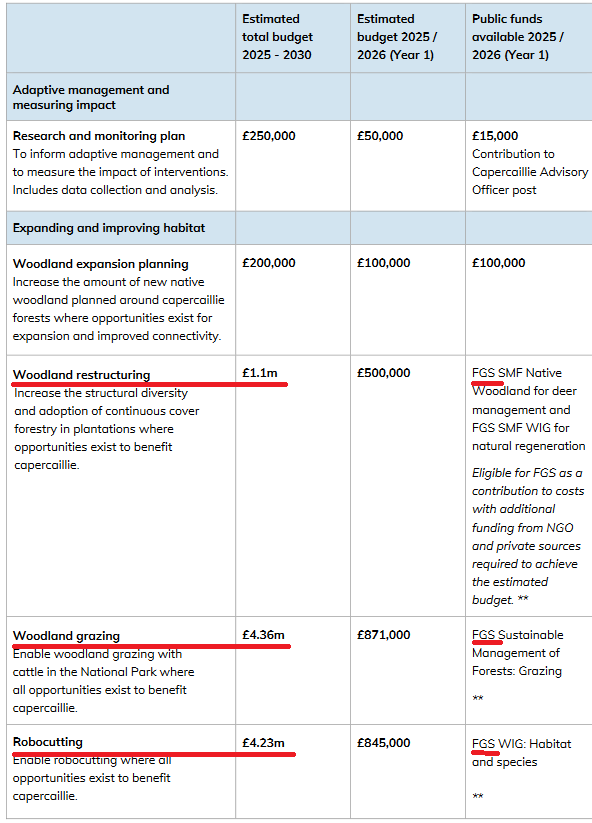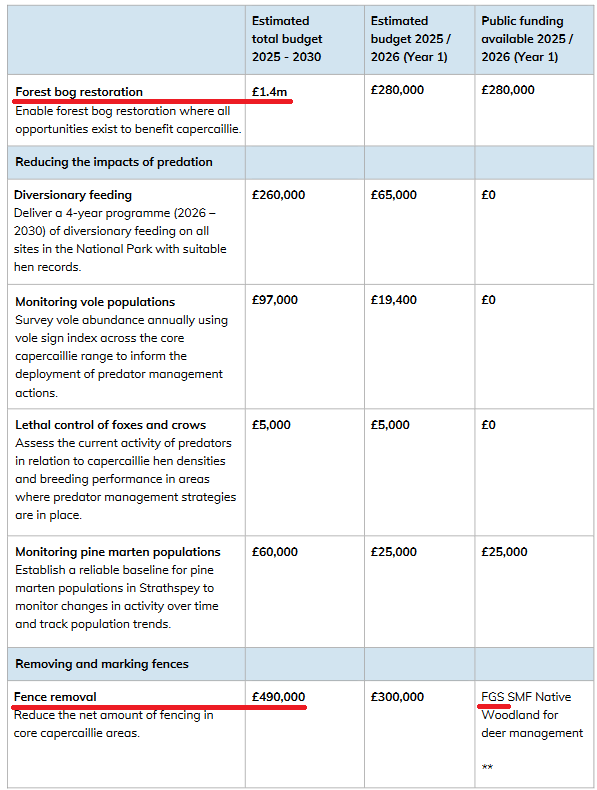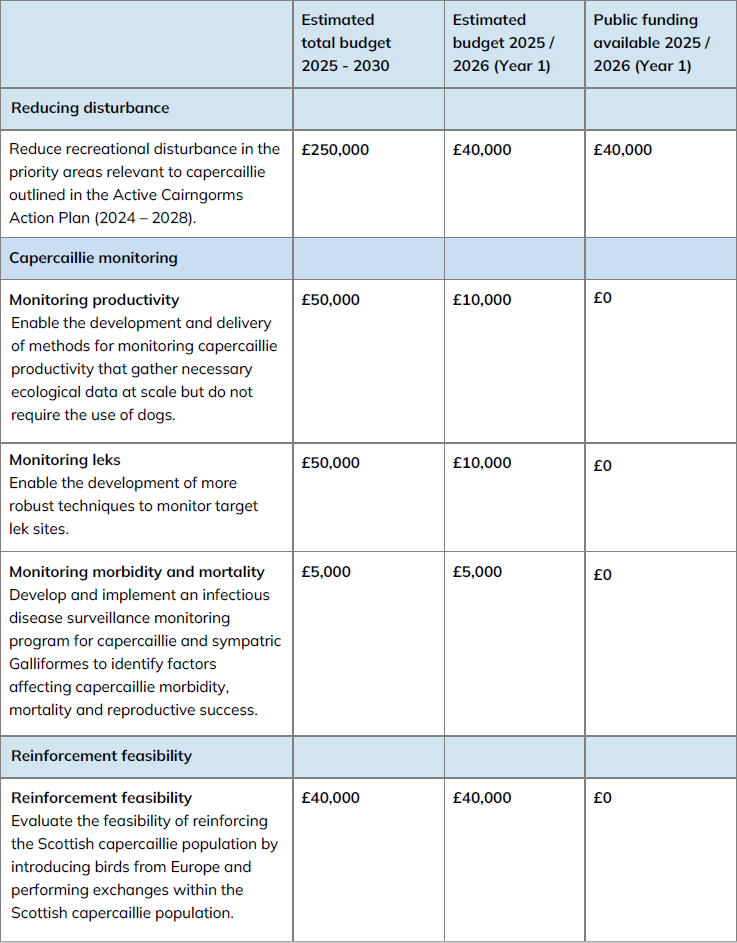On 30th September the Cairngorms National Park Authority (CNPA) and NatureScot launched a five year Emergency Plan for Capercaillie (see here) claiming it as “the most comprehensive plan of its kind ever produced for this iconic bird”. We have now moved from the Capercaillie Life Project 2002-07 to the Capercaillie Framework, launched in 2013, to a Capercaillie Emergency Plan. This post argues that the “Emergency Plan” fails to address the most important factors in the decline of the capercaillie and is therefore unlike to make much difference to their fortunes while potentially having serious implications for the rest of nature.
Background to the Capercaillie Emergency Plan
For almost two decades work to save the capercaillie has been primarily funded by the EU and the lottery. With funding for the Capercaillie Project due to run out last year, the Green MSP and then Minister responsible for National Parks and Nature, Lorna Slater, asked the CNPA and NatureScot to draw up a new plan for capercaillie. That was exactly the right thing to do but helps explain some of the failings in the Emergency Plan: Lorna Slater had no power over Scottish Forestry, the main potential sources of funds to restore the habitats on which capercaillie depend.
The work to develop the Emergency Plan was undertaken by the capercaillie project, prior to it terminating, through engagement with stakeholders it had identified. I was pleased to be asked to contribute and, while I was unable to attend any of the meetings with stakeholders, did make a submission to the draft plan (see here).
Unfortunately, however, there was no wider public consultation (I had undertaken not to publish the draft plan). Even more extraordinary, the CNPA Board was asked to approve the draft Emergency Plan at their meeting in June 2023 having only been given sight of its contents page (see here).

The minute of this meeting, published in September, shows that some Board Members challenged this but appear to have been effectively told by staff (and accepted) it was none of their business. The meeting also reveals that CNPA staff do not regard any of their board members as experts. As a consequence the final Emergency Plan has not been subject to any public scrutiny.
Nor did the paper to the board in June explalin that the Emergency Plan had been produced BEFORE the actions undertaken by the Capercaillie Project had been evaluated. An FOI response from NatureScot published on 29th September, asking for correspondence with the CNPA about capercaillie conservation, stated (see here):
“We have withheld a draft report NatureScot has been consulted on, ‘Evaluation and Monitoring Report of the Cairngorms Capercaillie Project’. This is due for publication by the Cairngorms National Park Authority next month”.
When that report appears it will be interesting to see if it contains any critical analysis of why capercaillie numbers have continued to decline despite all the actions taken to save them over the last 20 years.
Actions driven by money and vested interests, not science
The causes for the decline of capercaillie are complex, as Adam Watson and Robert Moss explained in their excellent book Grouse. They fall into three groups: factors affecting breeding success, from climate change to loss of suitable habitat; predation, by both humans and animals; and “accidental” collisions with fences. I will come back to consider some of the individual factors in more detail in further posts but my focus here will be on the bigger picture, science and money.
In February 2022 NatureScot published a report from its Scientific Advisory Committee called “Review of Capercaillie Conservation and Management”. It identified four measures as being “likely to have the greatest immediate positive impact on the population”. Three were concerned with breeding success and one with mortality rates:
- Predator control.
- Diversionary feeding of predators.
- Creation of refuges through permanent or seasonal closure of paths and tracks.
- Fence marking/removal.
The NatureScot report stated there was fairly strong evidence that “reducing the numbers of predators (foxes, pine martens, crows) would rapidly improve the breeding success of capercaillie” – contrary to Watson and Moss’s critique of the research on this in Grouse (which interestingly is not included in the references at the end of the report). Measures 2 and 3, however, were recommended despite the report admitting “There is currently limited or only circumstantial evidence as to whether diversionary feeding, path closure or path screening will have a positive impact on the Capercaillie population”.
Since February 2022 there has been a scientific trial conducted by the University of Aberdeen on the impact diversionary feeding had on saving artificial nests with chicken eggs from predation (see here). There have also been management initiatives by the RSPB at Abernethy, not scientifically evaluated, involving cattle grazing and robocutting. The Emergency Plan attributes far more importance and allocates far more budget to these specific measures than to measures that are much better evidenced or to landscape conservation as a whole:

The two largest budget lines by a country mile are for woodland grazing and robocutting, neither of which was even mentioned in NatureScot’s Scientific Advisory Group report produced just two and a half years ago or in the subsequent report by CNPA staff to their Board in June 2023 (see here). So where is the scientific evidence that these two measures are the most important things that need to be done to save the capercaillie?
While the Emergency Plan claims “A small-scale trial of heather cutting in Abernethy Forest in the early 2000s demonstrated a more than doubling of blaeberry cover and invertebrate biomass and a 7-fold increase in capercaillie usage” there is no mention of a more recent scientific study at Abernethy “Experimental cutting of the shrub layer did not improve capercaillie Tetrao urogallus breeding success during wet summers in Scots pine forests” (see here). The case for robocutting therefore appears unproven. Meantime the promotion of woodland grazing is based on a small trial at Abernethy where “ad hoc observations” showed “capercaillie usage of the grazed areas increased significantly” and the count of lekking males increased from 3 to 10 between 2019 and 2024. There is no evidence to show whether those observations are the result of capercaillie having moved into the area or whether the overall population has actually increased.
The budget for robocutting and woodland grazing therefore appears a panic response to “only around 532 capercaillie remaining in Scotland”. This could well be another complete waste of public money and has only been made possible because of the largesse of the Scottish Forestry Grants system, which is driven not by science but by vested interests (in this case the RSPB whose primary mission is to save birds whatever the consequences for the rest of nature). The £8.59m could be far better used.
While much of the content of the report to the CNPA board in June 2023 was about the complexities of creating “capercaillie refuges” and predator control – Lorna Slater had made it quite clear that the Scottish Government would not tolerate culling of pine marten, a protected spcies – it did refer to gaps others had highlighted in the NatureScot report. These included ts failure to consider the “benefits of ecosystem conservation rather than single species management”. Unfortunately both NatureScot and the CNPA have ignored that and the Emergency Plan promotes grazing of the Caledonian Pine Forest woodlands by (medicated) domestic animals instead of wild red deer and the human intervention of robocutting over natural processes, all in order to “manage” capercaillie.
The June 2023 CNPA Board report was, however, on firmer ground when it stated:
“Habitat improvement is the most important factor to achieve long-term sustainability of the population. This requires appropriate management of existing woodlands, reducing fragmentation, minimising fencing, and supporting the creation of new, more natural, native woodlands”.
The best way to improve habitats would be to reduce deer numbers to under two per square km to enable native pinewoods to expand and connect up through natural regeneration without any use of fencing. Unfortunately the Emergency Plan contains no new proposals to reduce deer numbers to enable this to be achieved. The target in the CNPA National Partnership Plan 2022-27 is 5-8 deer per square km on the open hill which means woodland, on which capercaillie depend, cannot expand without fencing which kills them (see here).
The Emergency Plan is far better when it comes to the restructuring of native woodland plantations. Capercaillie used to be quite common in Scots Pine plantations. While shooting by the Forestry Commmision in the 1970s took a major toll – capercaillie were regarded as pests as they ate the leading shoots of pine trees – intensification of forestry planting techiques also had an impact, with ever more drainage removing the boggy areas on which capercaillie chicks depend for invertebrates and fewer open areas reducing ground vegetation and cover. The justification for allocating £1.1m to “Woodland restructuring” and £1.4m to “Forest Bog restoration” is therefore far stronger than the allocations for robocutting and cattle grazing:

As long as these two budgets are applied to plantations, as opposed to Caledonian Forest remnants, they have the potential to benefit not just capercaillie but a range of other wildlife. The best things Scottish Forestry could now do is re-allocate the £8.59m budget allocated to cattle grazing and robocutting to restructuring plantations. (There might be a small role for some cattle grazing in plantations, particularly after they have been thinned/restructured, to help churn up the ground and encourage other vegetation growth).
By contrast to these four measures all the other budgets in the Emergency Plan, with the exception of Fence Removal, are insignificant. It is worth noting too that many have little or no public funding allocated towards them so may well not happen:

The lack of budget allocation for the research elements of the Emergency Plan is highly significant and will do nothing to improve how public funds are spent in future.
Fence removal
I have written several times about the impact of fences on capercaillie (see here), (here) and (here) and suffice to say that fence collisions are the biggest single cause of capercaillie mortality. Research also shows that while some types of fence marking can reduce collisions (the impact of much of the marking now used is not researched), signficant numbers still occur.
(Incidentally, snares, as Adam Watson and Robert Moss showed, also kill male capercaillie in particular but that is not mentioned either in the NatureScot report or in the Emergency Plan. With snares being banned in Scotland from Monday 25th November there is unfortunately no data on the use or impact of snares in the National Park which would enable the CNPA to assess the extent to which the ban might make a difference).
While NatureScot’s report concluded “There is good documentation that these fences cause injury and mortality to Capercaillie, especially during the first year of life where birds are dispersing”, it follows this with the unsubstantiaed claims that “There has been much progress in removing/marking deer fences over the last 20 years, especially in prime Capercaillie areas” and that because of this and lower capercaillie numbers “fence mortality is likely to have decreased rather than increased in the last 20 years”. As a consequence of these unsubstantiated claims it concluded that “it is highly unlikely that such mortality in post-fledging juveniles and adults have caused the apparent declines in population size over more recent years”.
In the absence of further research since that undertaken 20 years ago (which found approx 1 capercaillie dying for each 1km of unmarked deer fence annually) the data on fencing in the Emergency Plan suggests that it is still likely to be a major cause of premature capercaillie mortality:
“It is a target within the National Park Partnership Plan to minimise the amount of fencing across the Cairngorms National Park by removing redundant fences. Whilst this will benefit both capercaillie and black grouse, scope exists to do more with recent estimates of unmarked fencing in capercaillie areas
indicating that c15km remains within 1km of active lek sites; c86km within 1km – 3km; and c156km within 3 – 5km of active lek sites”.
With young capercaillie known to disperse up to 16km, that is up to 150km of fencing they could collide within the first 5km. In the face of this ecocide, caused by the failure of the CNPA and NatureScot to reduce deer numbers and the consequent need to plant trees within fenced enclosures, the Emergency Plan allocates £490k to Fence Removal. How much of the 150km of fencing this will remove is not stated.
The bigger problem, however, which is not mentioned in the plan is the amount of new fencing that is being erected in core capercaillie areas: recent examples include, Forest and Land Scotland’s MacAlpine plantation in the heart of the Glenmore Forest (see here), BrewDog’s Lost Forest (where much of the new fencing is not even marked) (see here) and the Muckrack woodland creation project (see here).
Despite stating that “With the threat of fencing removed, recent modelling by GWCT suggests
capercaillie numbers could be 16% higher and the risk of extinction within 50 years might fall from 95% to just 3%”, the Emergency Plan contains no provisions to end the erection of new fences by the forestry industry

This points to the key failing in the Capercaillie Emergency Plan. It does not address either the vested interests of sporting estates, who are responsible for the muirburn and high deer numbers which prevents the expansion of the Caledonian Pine Wood remnants – the prime habitat for capercaillie and a number of other threatened species – or the vested interests of the forestry industry, who prefer fenced plantation forestry to the type of continuous cover forestry that is practised on the continent and benefits wildlife.
Until the CNPA and NatureScot address these issues, the Capercaillie Emergency Plan will remain another greenwashing exercise designed to make the public think they are doing something for nature while all around us it continues to collapse.

The main problem faced by caper is that there are now so few of them, and ANY loss is proportionately more important now than it might have been in the past. The priority is to focus on getting MORE capercaillie, by whatever means is most effective. When I was on Deeside, we grazed cattle in the pinewoods and it did help the caper. To get that happening on a wider scale we should support farmers, not RSPB or CNPA to run woodland grazing as an experiment. There is no need for that.